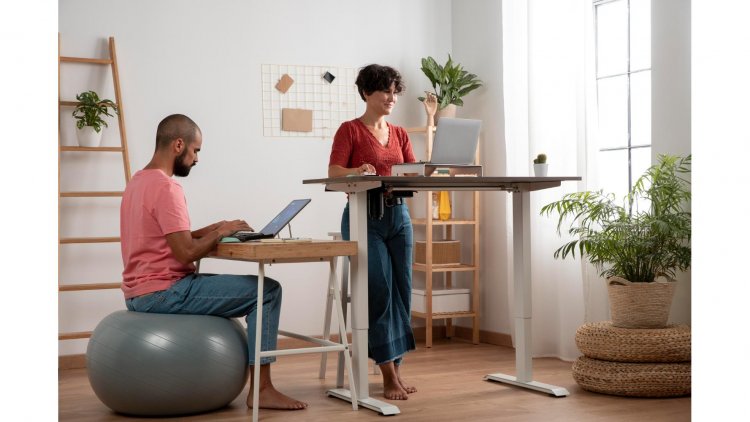Elevate Your Comfort: The Surprising Benefits of Standing Desks for Back Health
In today's world, where many of us find ourselves glued to a desk for hours on end, the need for better ergonomic solutions has never been more pressing. The conventional seated desk setup, once considered the epitome of office comfort, has increasingly been questioned for its impact on our health—particularly our back health. Enter the standing desk, a revolutionary tool that's gaining traction not just for its modern appeal, but for its potential benefits to our overall well-being.

Reclaiming Your Posture: The Standing Desk Revolution
The rise of the standing desk is not just a trend but a response to growing concerns about the detrimental effects of prolonged sitting. Research has shown that sitting for extended periods can lead to a host of health problems, from poor posture to chronic back pain. A standing desk, by allowing users to alternate between sitting and standing, offers a dynamic solution that aims to mitigate these issues.
The Mechanics of Back Health
To understand how standing desks can benefit your back health, it's crucial to grasp how prolonged sitting affects your body. When seated, the natural curve of your spine is often compromised, leading to increased pressure on the lumbar region. This prolonged pressure can result in discomfort and pain, particularly in the lower back. Additionally, sitting can weaken the muscles that support your spine, further exacerbating back problems.
By using a standing desk, you can promote a more natural spinal alignment. Standing encourages the use of your core muscles to support your back, which helps to maintain the spine's natural curvature. This shift in posture can alleviate the stress on your lower back and reduce the likelihood of developing chronic pain.
Enhanced Circulation and Reduced Pressure
Standing desks also help improve circulation, a crucial aspect of back health. When you sit for long periods, blood flow to your legs can become restricted, leading to discomfort and potential vascular issues. Standing promotes better blood circulation, which helps reduce the risk of developing conditions such as deep vein thrombosis and varicose veins.
Furthermore, standing reduces the pressure on your intervertebral discs—the cushioning pads between your vertebrae. When you sit, these discs are compressed, which can lead to discomfort and potential disc herniation over time. By standing more frequently, you alleviate some of this pressure, contributing to better overall spinal health.
Practical Tips for Using a Standing Desk
Transitioning to a standing desk involves more than simply switching from a seated to a standing position. To maximize the benefits and avoid potential discomfort, it's important to adopt proper ergonomics and adjust your workstation accordingly.
Ergonomic Setup
- Desk Height: Ensure that your desk is at an appropriate height. When standing, your elbows should be at a 90-degree angle, with your hands comfortably resting on the keyboard. Your screen should be at eye level to avoid straining your neck.
- Anti-Fatigue Mat: Consider using an anti-fatigue mat to reduce the strain on your feet and legs. These mats provide cushioning and encourage subtle movements that can enhance circulation.
- Foot Position: Alternate your weight between your feet and consider using a footrest or a small stool to rest one foot at a time. This practice can help reduce fatigue and promote better posture.
Gradual Transition
If you're new to standing desks, it’s advisable to start gradually. Begin with short standing intervals and slowly increase the duration as your body adjusts. This approach helps to prevent overuse injuries and allows your muscles to adapt to the new posture.
The Psychological Impact: More Than Just Physical Benefits
The benefits of standing desks extend beyond physical health. Psychological well-being is also positively impacted by the increased mobility and energy levels associated with standing desks.
Increased Energy and Productivity
Users of standing desks often report higher levels of energy and productivity. Standing encourages movement and reduces the sluggish feeling that can accompany prolonged sitting. This boost in energy can translate into improved focus and efficiency at work.
Enhanced Mood
The physical discomfort associated with prolonged sitting can contribute to stress and a negative mood. By alleviating back pain and discomfort, standing desks can contribute to a more positive work environment. Additionally, the increased energy and engagement that often accompany standing desk use can further enhance mood and overall job satisfaction.
The Science Behind Standing Desks
Recent studies have provided evidence supporting the health benefits of standing desks. Research published in journals such as the Journal of Physical Activity and Health and Occupational Health Psychology highlights several key findings:
- Reduced Back Pain: A study published in Occupational Health Psychology found that employees using standing desks experienced a significant reduction in back pain compared to those using traditional seated desks.
- Improved Mood and Energy: Research in the Journal of Physical Activity and Health indicated that participants using standing desks reported increased energy levels and improved mood.
- Enhanced Work Performance: Studies have also shown that standing desks can lead to improved work performance, as they contribute to higher levels of focus and productivity.
By integrating standing desks into the workplace, organizations can support the well-being of their employees, potentially reducing absenteeism and increasing overall job satisfaction.
Addressing Common Concerns
Despite the numerous benefits, standing desks are not without their challenges. It's important to address common concerns and misconceptions to ensure a successful transition.
Potential for Discomfort
Some users report initial discomfort when using standing desks. This discomfort can often be attributed to poor ergonomics or improper setup. By carefully adjusting your workstation and following ergonomic guidelines, you can minimize these issues.
The Risk of Overuse
Standing desks should not be viewed as a cure-all. Overuse, or standing for too long without moving, can also lead to discomfort and health issues. It’s essential to balance standing with sitting and incorporate movement throughout the day to maintain optimal health.
Embracing Balance: How to Make the Most of Your Standing Desk
Incorporating a standing desk into your daily routine is just the beginning of optimizing your work environment for better back health. To fully harness the benefits of a standing desk, a balanced approach to posture, movement, and ergonomics is essential.
Incorporate Movement
One of the most critical aspects of using a standing desk effectively is incorporating movement throughout your day. Standing in one place for extended periods can lead to discomfort and even negate some of the benefits. To avoid this:
- Use a Timer: Set a timer to remind yourself to switch between sitting and standing every 30 to 60 minutes. This helps maintain a dynamic work posture and reduces the risk of fatigue.
- Stretch Regularly: Take short breaks to stretch and move around. Simple stretches for your back, legs, and shoulders can help alleviate tension and promote flexibility.
- Walk During Breaks: Use your breaks to walk around the office or take a short walk outside. This not only helps with circulation but also provides a mental refresh.
Ergonomic Adjustments
Fine-tuning your workstation is key to maximizing the benefits of a standing desk. Consider the following adjustments:
- Monitor Position: Your monitor should be at eye level to prevent neck strain. A monitor stand or adjustable arm can help achieve the correct height.
- Keyboard and Mouse Placement: Ensure that your keyboard and mouse are positioned so that your elbows are at a 90-degree angle and your wrists are straight. This reduces strain on your shoulders and wrists.
- Chair Accessibility: Even with a standing desk, having a comfortable chair available for sitting when needed is crucial. Ensure that your chair is properly adjusted to support your back when you switch to sitting.
The Long-Term Impact of Standing Desks on Back Health
Adopting a standing desk is a step towards better back health, but it's important to consider the long-term effects and integrate other healthy habits.
Longevity and Health Benefits
Research suggests that the benefits of standing desks extend beyond immediate back relief. Over time, standing desks can contribute to a reduction in chronic conditions associated with prolonged sitting, such as cardiovascular disease and metabolic syndrome.
- Reduced Risk of Chronic Diseases: Regular use of a standing desk, combined with movement and ergonomic adjustments, can contribute to a lower risk of developing chronic conditions related to sedentary behavior.
- Improved Overall Fitness: Standing more often encourages a more active lifestyle, which can contribute to overall fitness and well-being. This includes improvements in cardiovascular health and weight management.
Personalizing Your Standing Desk Experience
To achieve the best results, personalize your standing desk setup to fit your individual needs and preferences. Consider the following tips:
- Experiment with Desk Accessories: Accessories such as sit-stand converters, monitor arms, and ergonomic chairs can enhance your standing desk experience. Experiment with different configurations to find what works best for you.
- Listen to Your Body: Pay attention to how your body responds to standing desk use. Adjust your posture, movement patterns, and workstation setup based on your comfort and any feedback from your body.
- Seek Professional Guidance: If you have specific back issues or concerns, consider consulting with an ergonomics specialist or physical therapist. They can provide personalized recommendations to optimize your desk setup and address any underlying issues.
Beyond the Desk: Holistic Approaches to Back Health
While standing desks offer significant benefits, they are just one part of a broader approach to maintaining back health. Incorporate additional strategies into your routine for a comprehensive approach to spinal well-being.
Exercise and Strengthening
Regular exercise, particularly core strengthening and flexibility exercises, plays a crucial role in supporting your back health. Incorporate activities such as:
- Core Exercises: Exercises like planks, bridges, and abdominal crunches strengthen the muscles that support your spine.
- Stretching: Incorporate stretching exercises that target the back, hips, and legs to maintain flexibility and reduce tension.
- Low-Impact Activities: Activities such as walking, swimming, or cycling promote overall fitness and reduce the risk of back pain.
Mindful Posture Practices
Maintaining good posture is essential for back health, both at your desk and throughout daily activities. Practice mindful posture habits such as:
- Proper Sitting Posture: When sitting, ensure your feet are flat on the floor, your knees are at a 90-degree angle, and your back is supported by the chair.
- Ergonomic Habits: Use ergonomic tools and techniques when lifting objects, such as bending at the knees and keeping your back straight.
- Regular Movement: Avoid staying in one position for too long, whether sitting or standing. Incorporate movement and stretching into your daily routine.
Healthy Lifestyle Choices
Adopting a healthy lifestyle can further support back health and overall well-being. Consider the following:
- Balanced Diet: Eat a balanced diet rich in nutrients that support bone and muscle health, including calcium, vitamin D, and protein.
- Hydration: Stay hydrated to maintain the elasticity of spinal discs and overall joint health.
- Sleep: Ensure you get adequate rest with a supportive mattress and pillow to promote spinal alignment during sleep.
The Future of Workplace Ergonomics
As awareness of the benefits of standing desks continues to grow, the future of workplace ergonomics looks promising. Companies are increasingly investing in ergonomic solutions and creating work environments that prioritize employee health and well-being.
Innovations in Ergonomics
Future developments in ergonomics may include:
- Advanced Desk Technologies: Emerging technologies such as smart desks that monitor posture and movement may provide personalized feedback to optimize health.
- Flexible Workspaces: The trend towards flexible workspaces, including adjustable desks and collaborative environments, supports a more dynamic and health-conscious approach to work.
- Enhanced Ergonomic Research: Ongoing research into ergonomics and workplace health will likely lead to new insights and innovations to further enhance well-being.
In summary, integrating a standing desk into your workspace offers significant benefits for back health, from improved posture and circulation to enhanced productivity and mood. By adopting proper ergonomics, incorporating movement, and maintaining a holistic approach to health, you can fully leverage the advantages of standing desks and support your overall well-being.
Disclaimer: The information provided in this article is for educational purposes only and should not be considered medical advice. If you have any health concerns or are experiencing symptoms, it is important to consult with a healthcare professional, such as a doctor or clinic, for proper diagnosis and treatment. Always seek the advice of your doctor or other qualified health provider with any questions you may have regarding a medical condition. Do not disregard professional medical advice or delay in seeking it because of something you have read in this article.
What's Your Reaction?





















